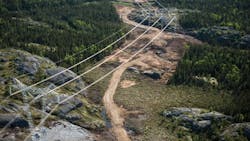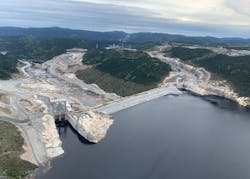Hydro-Quebec Faces Challenges in Constructing New 500-kV Transmission Line
Numerous Challenges
The territory where we built these lines is isolated and rugged. In the southern portion, which connects the Romaine 1 and 2 generating stations to the Arnaud station in Sept-Îles, is particularly steep.
For the line further north, which connects the Romaine-3 and 4 powerhouses to the Montagnais station, 175 km long, access to the territory is non-existent. So we had to use a railroad passing near the western portion of the transmission line, to be able to carry out this project.
Moreover, the weather in this area is difficult, especially in winter. At the same time, winter allows us to cross the territory more easily by making snow roads. In other words, in this part of the world, when it comes to a transmission project, winter is both a challenge and an asset.
The transmission lines to Rivière Romaine, which began in 2011, also includes construction of Romaine-1, Romaine-2 and Romaine-3 substations, which have been commissioned.
No Lodging
Another difficulty we faced while building these lines and substations was lodging. The local communities are small and we had to build three camps, each able to welcome about 250 workers. In a certain part of the Romaine-2/Arnaud line, we literally built a camp within a local community, Rivière-au-Tonnerre. By doing so, the local population doubled for several months. We had to proceed this way because the community did not have the lodging capacity to welcome so many workers. For the Romaine-4/Montagnais line, we had to build two camps for our workers.
Both Romaine-4 substation and powerhouse have been commissioned last fall. Environmental follow-up will take place for approximately 20 years. The project also includes building new switchyards at the generating stations.
The 1,550-MW hydroelectric complex, which sets on the Rivière Romaine, north of the municipality of Havre-Saint-Pierre and north shore of the St. Lawrence, underscores Hydro-Québec commitment to sustainable development and focus on renewable energy. Construction of transmission lines, which is a separate venture from the Romaine Complex, is connecting the 1,550-MW Romaine Complex to the rest of the grid in Quebec.
What we retain from this project is all the work that has been done with local communities, including aboriginal communities. This partnership allowed us to conceive efficient routes for our lines, routes that took the impact on the environment into account from the start.
Francis Labbé, is Spokesperson for Hydro-Québec. Former reporter for the Canadian Broadcasting Corporation, he is now responsible of Production, Environment and Aboriginal Affairs in the Media team of Hydro-Québec.
Mathieu Bolullo is is Senior Director, Transportation Projects, Construction and Distribution for Hydro-Québec. Engineer, Mr Bolullo has been involved in many projects. Among other things, he wes responsible for the construction of the Romaine complex as well as studies and projects for the rehabilitation of existing production facilities.
About the Author
Francis Labbé
Francis Labbé is Spokesperson for Hydro-Québec. Former reporter for the Canadian Broadcasting Corporation, he is now responsible of Production, Environment and Aboriginal Affairs in the Media team of Hydro-Québec
Mathieu Bolullo
Mathieu Bolullo is is Senior Director, Transportation Projects, Construction and Distribution for Hydro-Québec. Engineer, Mr Bolullo has been involved in many projects. Among other things, he wes responsible for the construction of the Romaine complex as well as studies and projects for the rehabilitation of existing production facilities.


